Sylvia Lefkovitz
Sylvia Lefkovitz (August 29, 1924 – April 21, 1987) was a Canadian artist known for her murals, oils, drawings, lithos and sculptures rendered in bronze, silver, marble, and Canadian wood. Her work has been exhibited all over the world and was profiled in the National Film Board of Canada's 1966 documentary In Search of Medea: The Art of Sylvia Lefkovitz.[1][2]
Sylvia Lefkovitz | |
|---|---|
 1949 self-portrait | |
| Born | August 29, 1924 |
| Died | April 21, 1987 (aged 62) Montreal, Quebec, Canada |
| Resting place | Baron de Hirsch Cemetery |
| Known for | Painter and sculptor |
Among her major pieces are the five-figure bronze Chorus, commissioned for the Mies van der Rohe complex in Montreal's Westmount Square; her Fathers of Confederation, commemorating the 1967 Canadian Centennial; her eighty-figure Divine Comedy, purchased by the Canadian government and exhibited in the Dante Room of the Royal Palace in Milan on the occasion of Dante's 700th birthday; and her eight bronze biblical panels in bas-relief, inspired by Ghiberti's Bronze Doors on the Florence Baptistery.[3][4]
Biography


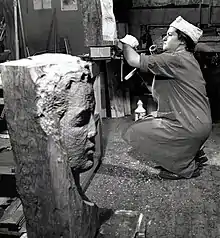
Sylvia Lefkovitz was born in Montreal, Quebec, to immigrant parents of Russian and Hungarian Jewish descent.[5][6] Lefkovitz first displayed a talent for drawing in elementary school, and by the seventh grade was already sketching portraits. She went on to attend Baron Byng High School where art teacher Anne Savage encouraged her to pursue her artistic ambitions.[7][8] Supported by her working-class parents, she embarked on a lifetime of study by taking classes at the École des beaux-arts de Montréal.[9][10]
After graduating high school, Lefkovitz began art studies at Columbia University in New York in 1941. She returned to Montreal a year later, working nights during the Second World War at Fairchild Aircraft while her days were spent studying at the Montreal Museum of Fine Arts School.[11][12] On scholarship at the school for drawing, she studied under Eldon Grier until 1946, when she returned to Columbia University for two more years.[12] While studying there under Oronzio Maldarelli and Henry Meloy, she supported herself by again working nights as a keypunch operator for the Blue Cross.[8][6][13]
After a brief return to Montreal, Lefkovitz decided to continue her studies at the Louvre and Académie Julian in Paris.[14] A year later, she moved on to Spain and Italy for a time before returning to Montreal, where she took a bookkeeping day job, taught art in the evenings, and "painted like mad."[15] She began experimenting in the ancient art form of encaustic painting, and in 1953, several of these works were exhibited in Montreal.[11][16]
Lefkovitz spent four months in Mexico in 1954, studying Orozco's mural techniques and observing the creation of major historical murals in the Pyroxylin medium (a lacquer technique).[17][10] The Mexican muralists' depiction of oppressed peoples and social injustice inspired her to apply their techniques to the interpretation of these issues in her own country.[18][10] Upon her return to Montreal, she received a commission from the Redpath Museum to create a series of murals depicting the life and career of Louis Riel.[19] The work won Lefkovitz her first major professional recognition.[10] The Riel mural was exhibited as part of the formal opening of the park on St. Helen's Island in Montreal by invitation of the Municipal Government. The panels were later purchased by the Department of Northern Affairs and National Resources and are on display in the National Historic Park in North Battleford, Saskatchewan.[11][20] The following year, a second series of historical panels depicting the expulsion of the Acadians was exhibited in Gallery XII in the Montreal Museum of Fine Arts. Those five panels, which run 60 feet in length and are six feet high, are now housed at the Université Sainte-Anne.[4][10][21]
In 1958, Lefkovitz was awarded an Arts Teachers Fellowship by the Canada Council to return to Mexico for a year, allowing her to devote all her time and attention to art for the first time.[3] In Mexico City, she experimented with different lacquers under Professor José L. Gutiérrez at the Instituto Politécnico Nacional, and further mastered her mural technique.[22] She also encountered the renowned painter David Alfaro Siqueiros, and they made plans to collaborate on a mural (it is unclear as to whether this work ever materialized).[23]
In 1959, Lefkovitz returned to her bookkeeping job in Montreal, painting in whatever spare time she had. By 1960, she had saved enough money to travel again, and headed to Italy; it was there that her focus shifted to sculpture. In the marble studios of Florence, she took an apprenticeship in carving, and in the city's ceramic factories, she learned the art of terra cotta.[24] Working in the foundries, she rapidly mastered the technique of lost-wax casting.[3][11] In 1962, she was awarded the Porcellino Award as the best resident foreign artist.[3] She returned home later that year, fluent in Italian and accompanied by nine crates of her painting and sculpture. The Waddington Galleries in Montreal mounted a solo exhibit of her artwork. She used this homecoming to begin sculpting with Canadian wood.[14][3] She travelled again in 1963, in Greece and Rome, finally settling in Milan, where she had her first major Italian solo exhibit at the Galleria Montenapoleone. The show won critical acclaim, and she was lauded for her interpretation of the Italian Renaissance tradition in both her painting and sculpture.[3][25]
Lefkovitz remained in Milan for the better part of seventeen years, living and working on a student visa.[3][6] The almost two-decade period was one of significant professional success, with a string of exhibitions, retrospectives, and awards. She also won major public and private commissions in both Europe and Canada, including The Chorus, Fathers of Confederation and the Divine Comedy. She returned to Montreal in 1981, where she worked and taught from both her Montreal studio (Studio 3) and at the Saidye Bronfman Centre School of Fine Arts until her death in 1987 at the age of 62.[17]
Major works
- Commissioned sculptures
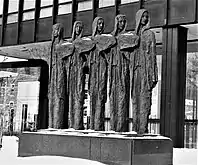 The massive five-figure bronze Chorus, commissioned for the Mies van der Rohe complex in Montreal's Westmount Square.
The massive five-figure bronze Chorus, commissioned for the Mies van der Rohe complex in Montreal's Westmount Square.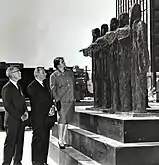 Unveiling of The Chorus in Montreal
Unveiling of The Chorus in Montreal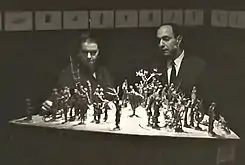 An 80-figure sculpture in bronze depicting Dante's Divine Comedy exhibited at the Royal Palace in Milan for the 700th anniversary of Dante's birth. Purchased by the Canadian government as a travelling exhibit of exemplary Canadian Art.[18]
An 80-figure sculpture in bronze depicting Dante's Divine Comedy exhibited at the Royal Palace in Milan for the 700th anniversary of Dante's birth. Purchased by the Canadian government as a travelling exhibit of exemplary Canadian Art.[18]_by_Sylvia_Lefkovitz.jpg.webp) Detail from The Divine Comedy: Dante, Virgil and the Wolf
Detail from The Divine Comedy: Dante, Virgil and the Wolf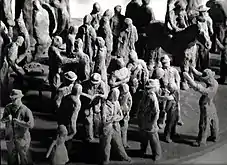 The original wax model of Fathers of Confederation – commissioned by the Government of Canada commemorating the 1967 Canadian Centennial with a casting gifted to all ten provinces.[22]
The original wax model of Fathers of Confederation – commissioned by the Government of Canada commemorating the 1967 Canadian Centennial with a casting gifted to all ten provinces.[22]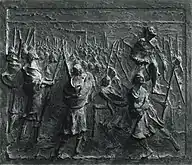 Samson Breaking His Binding Ropes – one of eight biblical bas-reliefs in bronze
Samson Breaking His Binding Ropes – one of eight biblical bas-reliefs in bronze
- The Acadian Murals
_by_Sylvia_Lefkovitz.jpg.webp) Panel 1 – First Nations People and the first Europeans to set foot on their land: a Viking, Jean Cabot and Samuel de Champlain.
Panel 1 – First Nations People and the first Europeans to set foot on their land: a Viking, Jean Cabot and Samuel de Champlain._by_Sylvia_Lefkovitz.jpg.webp) Panel 2 – 1604 – The arrival of the first French settlers to the French Bay (Fundy).
Panel 2 – 1604 – The arrival of the first French settlers to the French Bay (Fundy)._by_Sylvia_Lefkovitz.jpg.webp) Panel 3 – The Acadians lived off the land and the sea. Nova Scotia became a British possession in 1713, following the war between France and England.
Panel 3 – The Acadians lived off the land and the sea. Nova Scotia became a British possession in 1713, following the war between France and England._by_Sylvia_Lefkovitz.jpg.webp) Panel 4 – 1755 – The Deportation. The Acadians had refused to take the oath of unconditional allegiance to the King of England. They were dispossessed of all their property and exiled.
Panel 4 – 1755 – The Deportation. The Acadians had refused to take the oath of unconditional allegiance to the King of England. They were dispossessed of all their property and exiled._by_Sylvia_Lefkovitz.jpg.webp) Panel 5 – After 1764, the Acadians recovered their property rights in Nova Scotia. Many returned home.
Panel 5 – After 1764, the Acadians recovered their property rights in Nova Scotia. Many returned home.
Selected works
- Paintings by Sylvia Lefkovitz
 Village Square, 1977, oil on canvas, private collection
Village Square, 1977, oil on canvas, private collection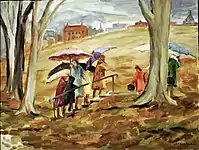 Umbrellas and Children, oil on board, Gallery Gevik
Umbrellas and Children, oil on board, Gallery Gevik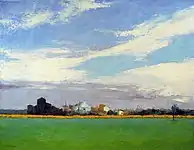 St. Lawrence River, 1983, oil on canvas, Gallery Gevik
St. Lawrence River, 1983, oil on canvas, Gallery Gevik On the Train, 1957, oil on board, Gallery Gevik
On the Train, 1957, oil on board, Gallery Gevik Street Scene After Snowfall, 1981, oil on canvas, Gallery Gevik
Street Scene After Snowfall, 1981, oil on canvas, Gallery Gevik Beach Scene with Umbrella, 1972, oil on canvas, Gallery Gevik
Beach Scene with Umbrella, 1972, oil on canvas, Gallery Gevik
- Sculptures by Sylvia Lefkovitz
 Dancers, 1981, bronze, private collection
Dancers, 1981, bronze, private collection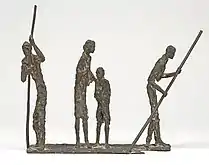 Naufragés sur un radeau, bronze, Valentin Gallery
Naufragés sur un radeau, bronze, Valentin Gallery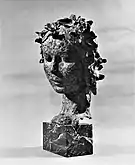 Primavera, (c.1961), bronze, private collection
Primavera, (c.1961), bronze, private collection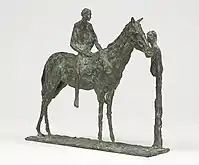 Horse, Rider & Woman, bronze, Valentin Gallery
Horse, Rider & Woman, bronze, Valentin Gallery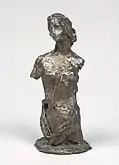 Salome, (c.1975), silver, Valentin Gallery
Salome, (c.1975), silver, Valentin Gallery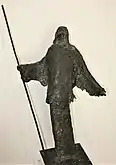 Moses, 1965, bronze, private collection
Moses, 1965, bronze, private collection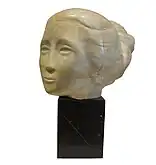 Barbara, (c.1961), marble, Gallery Gevik
Barbara, (c.1961), marble, Gallery Gevik Daphne, 1971, silver, private collection
Daphne, 1971, silver, private collection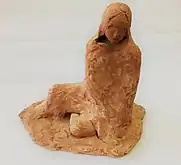 Woman, (c.1960), terracotta, private collection
Woman, (c.1960), terracotta, private collection
Selected exhibitions


- 2018 – The Hand and the Fire: The Life and Work of Sylvia Lefkovitz, Gallery Gevik, Toronto, Canada
- 2011 – Sylvia Lefkovitz: A Retrospective, Gallery Gevik, Toronto, Canada
- 2006 – Between Montreal, Mexico & Milan: Sculptures and paintings by Sylvia Lefkovitz, Valentin Gallery, Montreal, Canada
- 1975 – Retrospective, Fiat Company, Cultural Centre, Turin, Italy
- 1971 – The National Gallery of Canada, Ottawa, Canada
- 1969 – Sculpture, Canada House, London, England
- 1967 – Sculpture, Confederation Train and Caravans, Canada
- 1965 – Paintings, Palazzo Venezia, Rome, Italy
- 1962 – Paintings and sculpture, Palagio di Parte Guelfa, Florence, Italy
- 1957 – Paintings and murals, Montreal Museum of Fine Arts, Canada[28][4]
Selected collections
- Montreal Museum of Fine Arts, QC
- Musée Louis-Hémon de Péribonka, QC
- New Brunswick Museum, Saint John, NB
- Redpath Museum, McGill University, QC
- Batoche Historical Museum, SK
- Université Sainte-Anne, Pointe-de-l'Église, NS
- Musée d'art de Joliette, QC[29]
Major awards
- Premio Nazionale Grafica San Michele d'Oro, Italy, 1973
- Premio Nazionale di pittura figurative, Italy, 1973
- Premio Nazionale Grafica San Michele d'Oro, Italy, 1972
- Presented with the City of Genoa Shield for high artistic merit, Italy, 1972
- Premio Nazionale di pittura – Il Morazzone, Italy, 1971
- Porcellino award for the best resident foreign artist, Italy, 1962
References
- Carrière, Marcel; Samuels, Arthur (1966). In Search of Medea: The Art of Sylvia Lefkovitz (Film). Leo Clavir Productions and National Film Board of Canada.
- Perlman, Gary. "Sylvia Lefkovitz, Artist (1924–1987)". Jewish Genealogical Society of Montreal. Retrieved November 27, 2018.
- MacDonald, Colin S. A Dictionary of Canadian Artists. Vol. 3. Ottawa: Canadian Paperbacks Publishing. pp. 778–791.
- "Artist biography". Gallery Gevik. Retrieved August 30, 2018.
- Luzatto, G. L. (November 1964). "Artisti ebrei: L'illustrazione della Divina Commedia di Sylvia Lefkovitz". K'Eco dell'educazione Ebraica (in Italian). 18 (4): 11.
- MacNeill, Michelle (August 29, 2018). Personal interview with Barbara Samuels, niece of Sylvia Lefkovitz, July 18, 2018.
- Hill, Harriet (March 20, 1959) "Facts and Fancies". The Gazette, Montreal.
- Hill, Harriet (October 18, 1962) "Facts and Fancies". The Gazette, Montreal.
- Solomon, Heather (July 17, 1986). "Students respond to the "school of life" approach". The Canadian Jewish News.
- Samuels, A. (April 22, 1963). Letter to Department of Foreign Affairs and National Resources, Historic Sites Division.
- Pfeiffer, Dorothy (October 27, 1962). "One-Woman Show". The Gazette. Montreal.
- Mary Louise (October 15, 1959) "Local artist suggest travelling exhibition across Canada as aid". The Monitor, Montreal.
- Campini, Dino (1970). Arte Italiana Per Il Mondo. Vol. 1. Torino: Società editoriale Nuova. p. 161.
- "Bravo Sylvia!". The Elizabethan, Panorama de Ville Marie. 5 (10). February 1963.
- Shaw, Jean (August 9, 1956). "'Paint Simply,' Muralist Says". The Montreal Star.
- Richardson, Al (March 13, 1953) "Local Girl Revives Ancient Art". The Herald, Montreal.
- Solomon, Heather (March 16, 2006). "Lefkovitz lives again through her legacy". The Canadian Jewish News.
- Deakin, Basil (August 20, 1983). "Warm reception surprises Lefkovitz". The Chronicle Herald/The Mail-Star.
- "Lefkovitz, Sylvia". Canadian Women Artists History Initiative. Retrieved October 3, 2018.
- "Murals at Manuge Galleries Depict Expulsion of Acadians". Dartmouth This Week. Nova Scotia. August 18, 1983.
- Biermann, Helmer (July 11, 1986) "Biermann's Column". Evening Times Globe, New Brunswick.
- Levin Pinsky, Ryna (June 23, 1983). "MacDonald Avenue artist shows that art, intellect can mix". The Hampstead Journal.
- Lefkovitz, Sylvia (January 28, 1959) Letter/Progress Report to the Secretary of the Canada Council from Mexico regarding her grant.
- Goodman, Joyce (July 30, 1962) "Artist's Luggage Weighs Two Tons". The Montreal Star.
- Lefkovitz, Sylvia (1983). Biography.
- Appleby, Timothy (September 1, 2012). "Group of Seven paintings stolen after Toronto gallery window smashed". The Globe and Mail.
- Gallant, Jacques (September 1, 2012). "Group of Seven art stolen from gallery". Toronto Star. Toronto.
- "Biography of Sylvia Lefkovitz". Jean-Pierre Valentin Gallery. Retrieved August 30, 2018.
- "Exhibits". Sylvia Lefkovitz. Retrieved November 27, 2018.